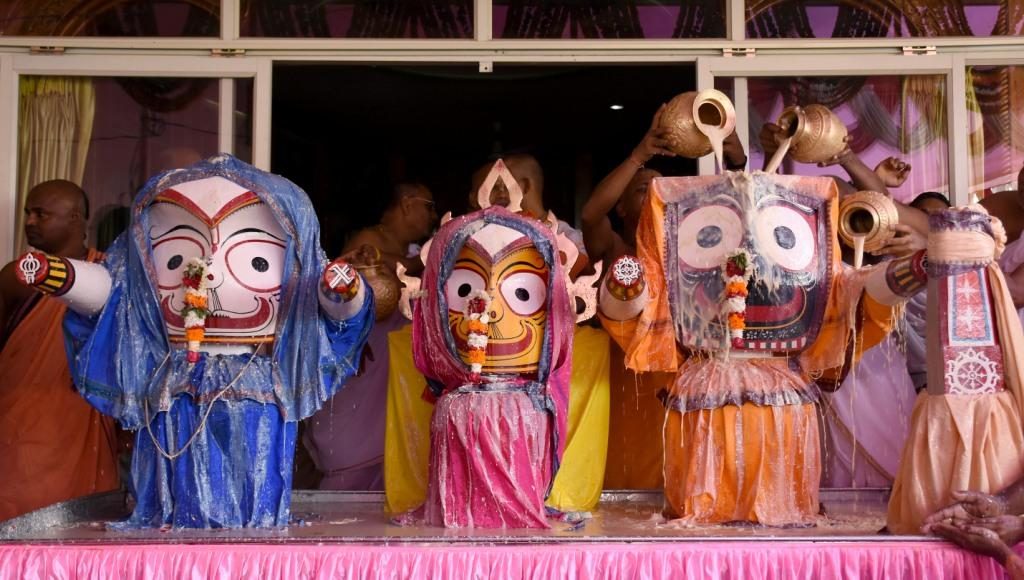A belief which is associated with this ritual, which takes place on the full moon day in the month of Jyestha, is that a devotee washes away all his/her sins if s/he gets a vision of the Lord on this day
BHUBANESWAR: The sacred festival of Lord Jagannath’s Snana Yatra was celebrated Monday at ISKCON temple in Nayapalli, Vishnu Mandir at Sahidnagar and at many other temples here apart from Srimandir in Puri.
This celebration takes place on the full moon day in the month of Jyestha which is known as ‘Devasnana Purnima’ or ‘Snana Yatra’ (bathing festival). There is a general belief that the devotee washes away all his sins if s/he gets a vision of the Lord on this day. Therefore, it attracts thousands of pilgrims from all over the world.
Ambika Debata, a regular at Snana Yatra at ISKCON temple, said: “This festival makes me and other devotees speechless as Mahaprabhu takes holy bath which is the rarest of rare thing for common people to see. It’s like attaining moksha in your lifetime.”
Pandit Pujahari, a water pitcher collector at the temple, stressed on the faith that is entwined with the ritual which makes this holy event a must watch.
The story of Snana Yatra at Puri, according to Skanda Purana says: when King Indradyumna installed the wooden deities in the temple, he arranged this bathing ceremony. On the eve of Snana Yatra, the images of Lord Jagannath, Lord Balabhadra and Goddess Subhadra along with the image of Sudarshana are ceremonially brought out from the inner sanctum of the main temple in a procession called ‘Pahandi’ in local language to the Snana Mandap (bathing pandal).
This bathing platform is in the north-east of Ananda Bazar and beside the outer wall of the temple called Meghanada Pacheri locally. The platform is at such a height that visitors standing outside the temple also get a clear view of the deities.
On this auspicious day, the Suaras and Mahasuaras go in a ceremonial procession to fetch 108 pots of water from the Golden Well called ‘Suna Kua’ in local language. The holy water is drawn from this well once a year.
During the entire process all of them cover their mouths with a piece of cloth so as not to contaminate the water even with their breath. Then all the pots filled with water are preserved in the Bhoga Mandap. Then the priests purify the water with haldi (turmeric), java (whole rice), sandal (chandan), flowers and perfumes.
The filled and purified water pots are then carried from Bhoga Mandap to the bathing platform by the Suaras in a long single line queue. This ritual is called Jalabhisheka meaning water bath. It is accompanied by chanting of Vedic mantras by the priests, kirtana and blowing of conch shells.
In the evening, after the bath ritual, the deities assume a special elephant form which is otherwise known as ‘Hati Besa’. While Lord Jagannath and Lord Balaram are dressed like elephants, Goddess Subhadra wears a lotus flower Besa.
After Snana Yatra, the deities are supposed to fall ill (fever) and do not return to their respective pedestals. The deities are kept in a special room called Ratan Vedi inside the temple. They stay away from public view for a period of 15 days. This period is known as Anasara. During Anasara, the deities are offered only fruits and water mixed with butter and Dasamula medicines to recover from fever.
The deities are treated by the Raj Vaidya (the King’s physician) with specific medicines (Dasamulas). During all these days the daily rites of the temple remain suspended. Due to the sacred bath with 108 pitchers of water, the colours painted on the images fade out. The Daitas repaint the images with new colours and on the 16th day the deities appear in their new forms for public view.
The festival of the first appearance of Lord Jagannath to his devotees is called Netrotsava (festival for the eyes) or Nava Yauvanotsava.
